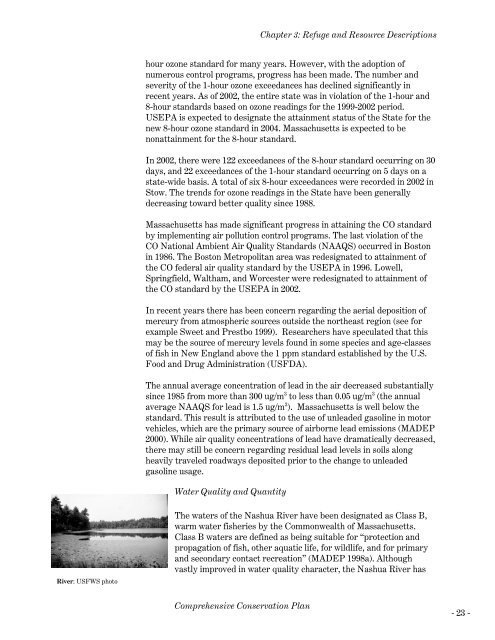Oxbow NWR Final CCP - U.S. Fish and Wildlife Service
Oxbow NWR Final CCP - U.S. Fish and Wildlife Service
Oxbow NWR Final CCP - U.S. Fish and Wildlife Service
You also want an ePaper? Increase the reach of your titles
YUMPU automatically turns print PDFs into web optimized ePapers that Google loves.
River: USFWS photo<br />
Chapter 3: Refuge <strong>and</strong> Resource Descriptions<br />
hour ozone st<strong>and</strong>ard for many years. However, with the adoption of<br />
numerous control programs, progress has been made. The number <strong>and</strong><br />
severity of the 1-hour ozone exceedances has declined significantly in<br />
recent years. As of 2002, the entire state was in violation of the 1-hour <strong>and</strong><br />
8-hour st<strong>and</strong>ards based on ozone readings for the 1999-2002 period.<br />
USEPA is expected to designate the attainment status of the State for the<br />
new 8-hour ozone st<strong>and</strong>ard in 2004. Massachusetts is expected to be<br />
nonattainment for the 8-hour st<strong>and</strong>ard.<br />
In 2002, there were 122 exceedances of the 8-hour st<strong>and</strong>ard occurring on 30<br />
days, <strong>and</strong> 22 exceedances of the 1-hour st<strong>and</strong>ard occurring on 5 days on a<br />
state-wide basis. A total of six 8-hour exceedances were recorded in 2002 in<br />
Stow. The trends for ozone readings in the State have been generally<br />
decreasing toward better quality since 1988.<br />
Massachusetts has made significant progress in attaining the CO st<strong>and</strong>ard<br />
by implementing air pollution control programs. The last violation of the<br />
CO National Ambient Air Quality St<strong>and</strong>ards (NAAQS) occurred in Boston<br />
in 1986. The Boston Metropolitan area was redesignated to attainment of<br />
the CO federal air quality st<strong>and</strong>ard by the USEPA in 1996. Lowell,<br />
Springfield, Waltham, <strong>and</strong> Worcester were redesignated to attainment of<br />
the CO st<strong>and</strong>ard by the USEPA in 2002.<br />
In recent years there has been concern regarding the aerial deposition of<br />
mercury from atmospheric sources outside the northeast region (see for<br />
example Sweet <strong>and</strong> Prestbo 1999). Researchers have speculated that this<br />
may be the source of mercury levels found in some species <strong>and</strong> age-classes<br />
of fish in New Engl<strong>and</strong> above the 1 ppm st<strong>and</strong>ard established by the U.S.<br />
Food <strong>and</strong> Drug Administration (USFDA).<br />
The annual average concentration of lead in the air decreased substantially<br />
since 1985 from more than 300 ug/m 3 to less than 0.05 ug/m 3 (the annual<br />
average NAAQS for lead is 1.5 ug/m 3 ). Massachusetts is well below the<br />
st<strong>and</strong>ard. This result is attributed to the use of unleaded gasoline in motor<br />
vehicles, which are the primary source of airborne lead emissions (MADEP<br />
2000). While air quality concentrations of lead have dramatically decreased,<br />
there may still be concern regarding residual lead levels in soils along<br />
heavily traveled roadways deposited prior to the change to unleaded<br />
gasoline usage.<br />
Water Quality <strong>and</strong> Quantity<br />
The waters of the Nashua River have been designated as Class B,<br />
warm water fisheries by the Commonwealth of Massachusetts.<br />
Class B waters are defined as being suitable for “protection <strong>and</strong><br />
propagation of fish, other aquatic life, for wildlife, <strong>and</strong> for primary<br />
<strong>and</strong> secondary contact recreation” (MADEP 1998a). Although<br />
vastly improved in water quality character, the Nashua River has<br />
Comprehensive Conservation Plan<br />
- 23 -

















